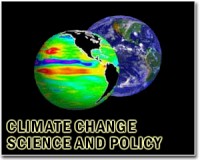 |
Albuquerque NM (SPX) Jul 27, 2010 A climate-change study at Sandia National Laboratories that models the near-term effects of declining rainfall in each of the 48 U.S. continental states makes clear the economic toll that could occur unless an appropriate amount of initial investment - a kind of upfront insurance payment - is made to forestall much larger economic problems down the road. Why tie climate change to economics? "Absent any idea of costs, the need to address climate change seems remote and has a diluted sense of urgency," study lead George Backus said. The Sandia study uses probability techniques familiar to insurance companies. Tables place dollar estimates on the effects of climate change in the absence of mitigation or other policy initiatives over the 2010-2050 time period. The analysis is based upon results delivered by a variety of computational models reported by the Intergovernmental Panel on Climate Change's Fourth Assessment Report. From those, the Sandia report estimates the range of precipitation conditions - from lows to highs - that could occur across the states. The study then presents the consequence of those levels of precipitation on the states' economies. "On the one hand, there's a lot of uncertainty in quantifying climate change," said Backus. "Everyone sees that. It's this uncertainty that presents the greatest difficulty for policy makers. If society knew how change would exactly unfold, we could undertake adaptation and mitigation responses." Yet, Backus and his team wrote in the introduction to their paper, in other areas of interest to society, "despite uncertainty about the future, cost-benefit analyses are conducted on a daily basis as aids for policymakers on issues of critical importance to the nation such as health care, social security and defense." By summarizing consequences over the range of predicted change - from the smallest to the greatest - the Sandia study is able to present a coherent grouping of results. Then, using well-accepted computer models, the study projects the net effect of climate change on a state's agricultural and industrial base, and the subsequent movement of populations for livable wages. California, the Pacific Northwest and Colorado, for example, are the only states in the study that seem to benefit overall from the variation in precipitation that climate change might engender. That is because population would leave those states whose economy is hit hardest by reduced water availability, moving into and stimulating the economies of the less-affected states. While the uncertainty in climate change predictions are often given as a reason by those skeptical of climate change to ignore the problem because of the wide range of model results, the study's authors take a point of view more common to insurance companies. In insurance, Backus said, greater uncertainty means greater risk. In such cases, insurance companies merely reflect the higher risk in a higher insurance premium. For example, the rates for well-understood risks, such as taking a commercial airline flight, are far lower than those for less-understood risks, such as taking a privately funded rocket flight. "One can emphasize the limitations of climate-change models, if one wants," said Backus. "But the real effect of that is to accentuate risk. To an insurance company, it would mean an area is more dangerous, not less. The proper action for those who want to halt government initiatives in climate policies is to reduce the uncertainty, not raise it. They need to demonstrate, if possible, that the future climatic conditions will remain below dangerous levels." Thus far, the only existing models say that if nothing is done now, "by the time the negative effects of climate change significantly affect populations, it will be too late to prevent the escalating damage," Backus said. Though the study stops short of applying its techniques to address effective mitigation techniques, its writers mention the early building of sea walls against the expected rise of oceans, planting crops resistant to drought and removing carbon from the atmosphere through reforestation or geological sequestration. A further limitation is that the study only considers the impacts of near-term climate change on the U.S., disregarding worldwide impacts. It also has the imprecisions that result from neglecting a large number of influencing factors. It does not provide a risk analysis or reliability study of amelioration techniques. But the study concludes that "the larger challenge lies not in the technical difficulties of such [analyses] but rather in the communication of the risk and uncertainty in a manner that connects to the vital concerns of the policymakers." The take-away point from the study? "It is the uncertainty associated with climate change that validates the need to act protectively and proactively."
Share This Article With Planet Earth
Related Links Sandia National Laboratories Climate Science News - Modeling, Mitigation Adaptation
 US Senate deals blow to global climate talks
US Senate deals blow to global climate talksWashington (AFP) July 24, 2010 A year and a half after President Barack Obama breathed new life into global talks on a climate treaty, the United States is back in a familiar role - the holdout. The Senate's decision Thursday to shelve legislation on climate change is certain to cast a long shadow over December's meeting in Cancun, Mexico that will work on a successor to the Kyoto Protocol. Obama's Democratic allies ... read more |
|
| The content herein, unless otherwise known to be public domain, are Copyright 1995-2010 - SpaceDaily. AFP and UPI Wire Stories are copyright Agence France-Presse and United Press International. ESA Portal Reports are copyright European Space Agency. All NASA sourced material is public domain. Additional copyrights may apply in whole or part to other bona fide parties. Advertising does not imply endorsement,agreement or approval of any opinions, statements or information provided by SpaceDaily on any Web page published or hosted by SpaceDaily. Privacy Statement |